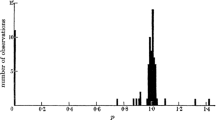Summary
Some aspects of the thermodynamical behaviour of certain fluids when they are made to occupy very flat spaces (their density being held constant) are investigated. The zero point energy change of liquid4He (a problem first considered byK. R. Atkins is studied in Sect.2 on the basis of two different models. The changes in the internal energy and in the free energy of two types of Bose-Einstein perfect gases in a state of partial condensation are analized in Sect.3.
Riassunto
Vengono studiati certi aspetti del comportamento termodinamico di alcuni fluidi quando siano costretti in spazi laminari sufficientemente piatti. In particolare vengono prese in considerazione:a) la variazione dell’energia di zero dell’4He (problema considerato per la prima volta daK. R. Atkins);b) le variazioni di energia interna e di energia libera di due tipi di gas ideali di Bose-Einstein (differenti per lo spettro energetico) in stato di parziale condensazione.
Similar content being viewed by others
References
S. Franchetti:Nuovo Cimento,4, 1504 (1956).
K. R. Atkins:Canad. Journ. Phys.,32, 347 (1954);Conférence de Physique des Basses Températures, Paris 1955, p. 100.
H. C. Kramers, J. Wasscher andC. J. Gorter:Physica,18, 329 (1952).
The contrary hypothesis ofC depending on direction may appear singular for a liquid. But in the particular case aimed at, namely helium films, a certain amount of uniaxicity would arise because the film is subject to strong forces normal to the wall. (See for instance the graph of density versus distance in Fig. 5, of ref. (1)). We come back to this point at the end of the section.
InAtkins’ treatment anegative term inλ D /t appears in the expression for the zero point energy, besides the (λ D /t)2 term, as for instance in eq. (19) ofCanad. Journ. Phys., ref. (2)). That would not be consistent with a minimum ofE 0 fort=∞. In fact, the sign should bepositive, the error arising from having inadvertently started withn s =0 (instead ofn s =1) the summation leading to eq. (16). The term in question disappears altogether by taking into account the minimum properties ofE 0, as has been done here.
S. Franchetti:Nuovo Cimento,12, 743 (1954);2, 1127 (1955).
In ref. (11 1—st), the value ofμ is given as 14·10−24 through a numerical slip in the computation.
The order of magnitude forΛ is 5.6·10−8 T −1/2 cm, withμ as in the foregoing Section (eq. (12″)).
Let it be noted that the staten z =n y =n z =1 is not considered as the fundamental one. The fundamental state (whose energy is taken as zero) is one in whichp=0 (at least for macroscopic samples. And the film is to be considered as such, under this respect, apart from the small correction dealt with in Sect.2·2). For the justification of this assumption see ref. (11).
G. G. Macfarlane:Phil. Mag.,40, 188 (1949).
Values for the ζ-function sufficiently accurate for the present purpose can be found inE. Jahnke andF. Emde:Tables of Functions (New York, 1945), p. 273. Values for the derivative ζ′ may be obtained from the Hurwitz formula, which is to be found, for instance, inE. T. Whittaker andG. N. Watson:Modern Analysis (Cambridge, 1946), p. 269.
J. Reeckie andT. S. Hutchinson:Phys. Rev.,92, 827 (1953).
D. G. Hurst andD. G. Henshaw:Phys. Rev.,100, 994 (1955).
No attempt was made to perform again the lengthy calculations leading toϕ andμ on the basis of the new values.
Author information
Authors and Affiliations
Rights and permissions
About this article
Cite this article
Franchetti, S. On the problem of the static helium film. Nuovo Cim 5, 183–202 (1957). https://doi.org/10.1007/BF02812826
Received:
Published:
Issue Date:
DOI: https://doi.org/10.1007/BF02812826



